Justin Sullivan/Getty Images News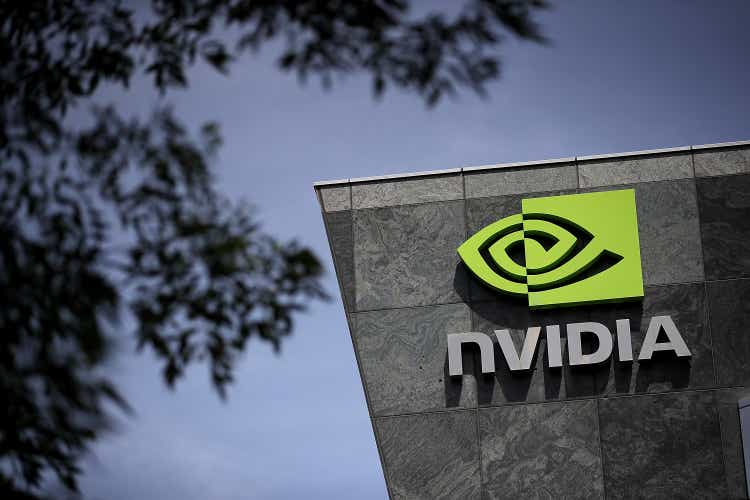
The Age of Artificial Intelligence is upon us. NVIDIA (NASDAQ:NVDA) is leading the revolution through its build-out of a comprehensive accelerated computing platform, laying the foundation for democratizing AI for thousands of businesses. This is a substantial opportunity as its AI enterprise solution has the potential to support trillions of dollars of end markets and generate billions in high-margin revenue for shareholders. Despite only launching the licensed software product in 2021, the company is already gaining momentum with large corporations signing up across a diverse set of industries. Every license that it sells will spin the flywheel faster and bolster its durable economic moat. In my view, the market is not adequately accounting for this future growth.
Nvidia is Strategically Positioned to Dominate the Market
You may believe that AI will proliferate across industries and radically change the world. It still raises the question: Why is Nvidia the business that will emerge as a prime beneficiary? You may ask, “Yeah, I understand AI and accelerated computing is promising, but isn’t the market flooded with a sea of competitors vying to capture profits? How can you possibly pick out the winner?” This is a great question.
In a memo written immediately before the dot-com crash, Howard Marks, the founder of Oaktree Capital, addressed the problem of picking winners in an industry whose technology promises to transform society.
Of course, the entire furor over technology, e-commerce and telecom stocks stems from the companies’ potential to change the world. I have absolutely no doubt that these movements are revolutionizing life as we know it, or that they will leave the world almost unrecognizable from what it was only a few years ago. The challenge lies in figuring out who the winners will be, and what a piece of them is really worth today.
As usual, Buffet puts it as succinctly as anyone could: “The key to investing is not assessing how much an industry is going to affect society, or how much it will grow, but rather determining the competitive advantage of any given company and, above all, the durability of that advantage.
Howard Marks, “Bubble.com“
Marks correctly points out that it is not good enough to understand whether a particular industry or technology will make an outsized impact when making an investment. My belief is that Nvidia will generate significantly more cash flows in the future not simply because it is riding the wave of a quickly growing industry, but rather because its products and services provide tremendous value and cost savings to its customers. Furthermore, it is hyper-focused on building a powerful economic moat around its business that is difficult for its competitors to compete with. For instance, it is the only supplier that can ship a turnkey data center system with a fully unified architecture. The breadth and depth of its solution are unparalleled in the market. The physical components are fully programable with Nvidia’s proprietary software layer. This layer enables engineers to tap into the incredible horsepower of the accelerated hardware. This architecture design incentivizes its customers to take advantage of its capabilities by tightly integrating the platform with their systems and applications, thus significantly raising switching costs.
Management is not shy about this strategic point of differentiation. For instance, Piper Sandler asked Nvidia’s VP of Enterprise Computing if anyone else in the space is close to delivering a complete package that is competitive with Nvidia’s offering.
But I would say we do not think so, right? But I will elaborate on that, right? If you think about the picture shown in my slide, the point we made was this is really a full stack problem from the piece parts of the hardware to the systems, to the low level of software, to the frameworks on top. We’re the only company in the planet that has been working on all of these limits. We believe we are really the only company in the planet, Harsh, that has focused on the entire stack, right? And that’s why we need to really optimize it and tailor it for these businesses.
Manuvir Das, Piper Sandler 2021 Virtual Global Technology Conference
This full-stack solution includes GPUs, CPUs, DPUs, SOCs, lightning-fast networking interconnect equipment, SDKs, libraries, virtual worlds simulations, AI models, software services, and more. These components have enabled Nvidia to deliver exceptional performance and consistently dominate the competition in MLPerf AI Benchmarks.
MLPerf Benchmarks (Nvidia)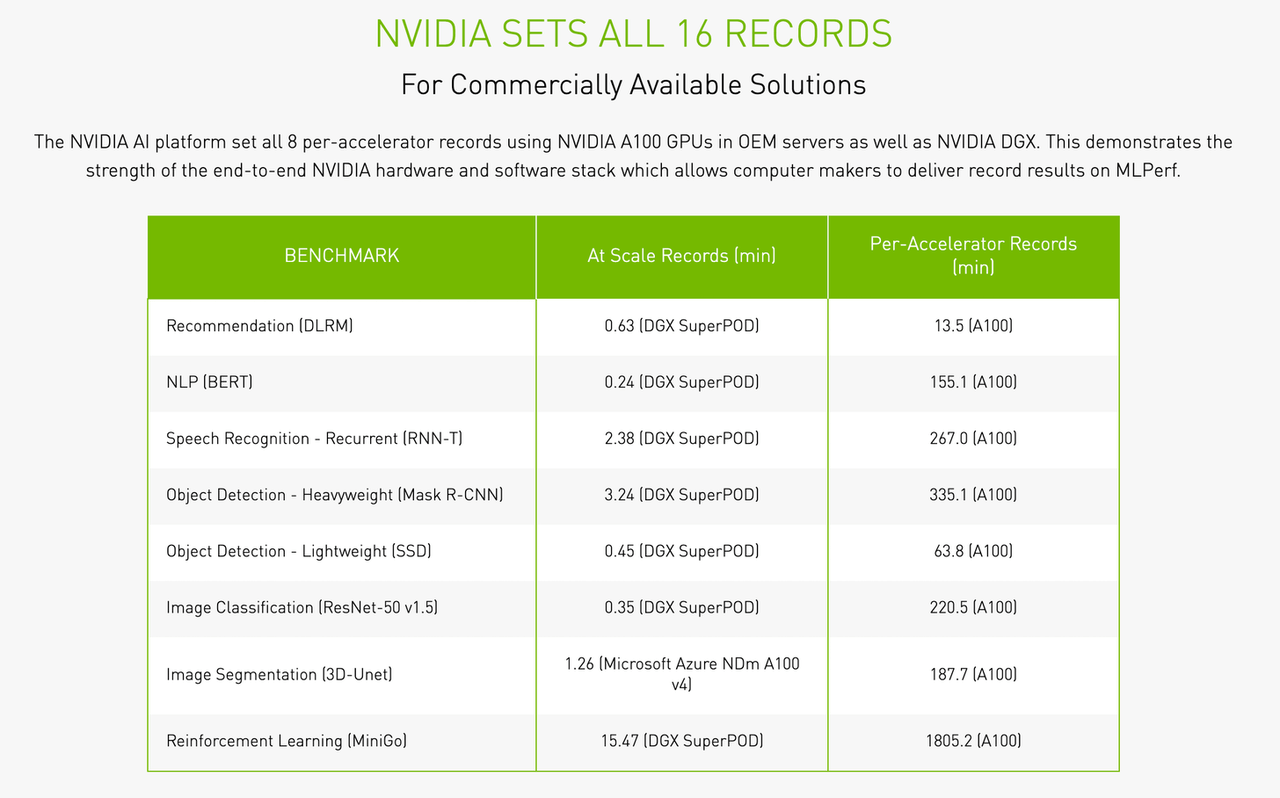
The Proof is in the Numbers
Nvidia’s operating results demonstrate the expanding economies of scale. By far, the most significant contribution of profits has come from the Datacenter and Gaming segments, which are a combined ~86% of total revenues.
Gaming is the company’s bread and butter. It boasts a high degree of penetration in the market with a 78% market share in PC discrete GPUs, over 200 million gamers using GeForce, 76% share of gamers who use its GPUs according to the latest May 2022 Steam survey, and 15 million+ GeForce NOW subscribers. This strong market leadership and a foundation for favorable overall industry growth have produced a healthy 25% 5-year CAGR. Despite a tough macro environment and a downturn in the crypto market, the business should continue to have multiple tailwinds at its back with the adoption of its RTX GPUs for its state-of-the-art ray-tracing capabilities, the rise of eSports, further market penetration of its GeForce NOW streaming service, and the growing popularity of speculative gaming through platforms like Twitch.
Nvidia Annual Specialized Markets Revenue (Image created by author with data from Nvidia 10K)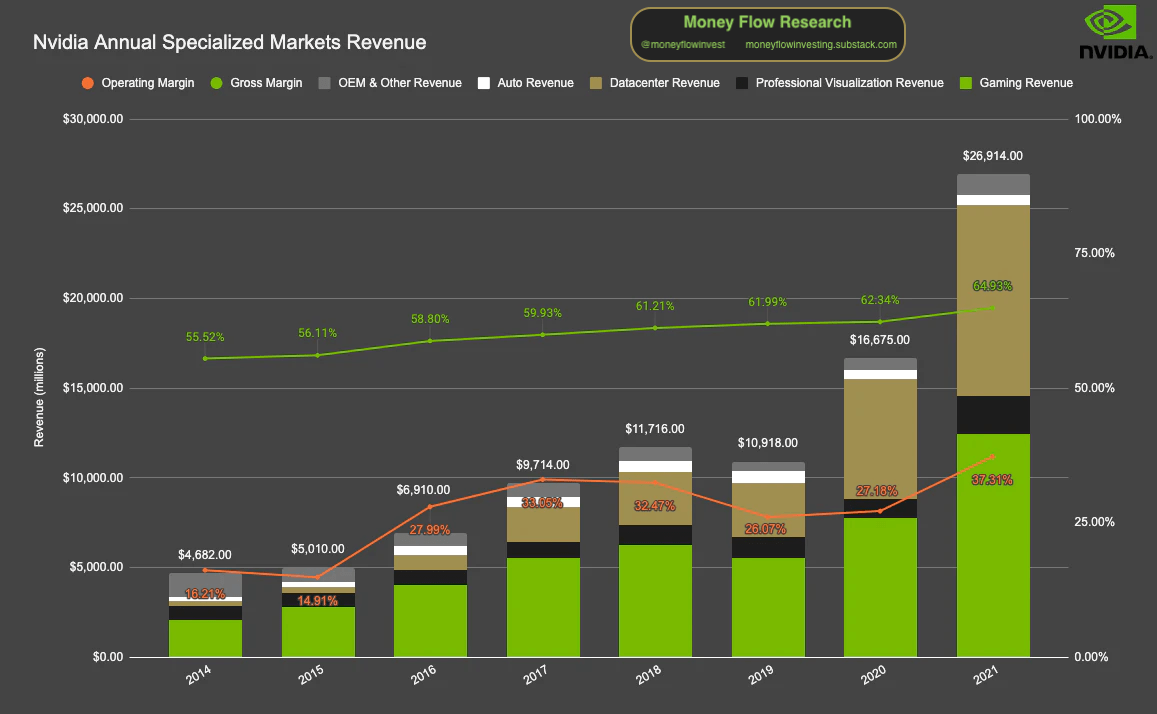
The other significant contributor to gross margins is the data center. As shown in the graphic below, its data center products have a higher gross margin profile than the rest of the business units. Thus, the seven-year 65% Data Center CAGR vs. 28% overall is mainly responsible for operating and gross margins expansion.
Nvidia Gross Margin Segment Profile (2021 Nvidia GTC Presentation)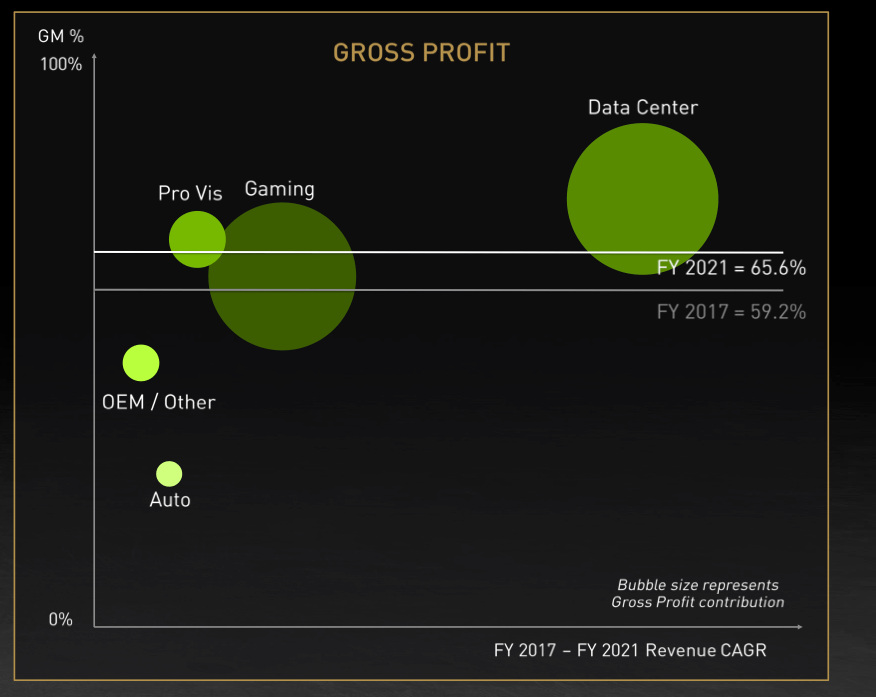
Much of the gains in operating margin have come from COGS reduction as a % of revenue. The gross margin should expand further as the sales mix continues to shift toward the data center and SaaS revenue. There is still room to gain further operating leverage in the mid to long term for both R&D and SGA, representing a combined 17.5% of revenue. I do not anticipate research costs showing much operating leverage within the next few years as the business invests heavily in IP. I expect SGA costs, on the other hand, to trend downward by roughly 1-2% over the next five years.
Nvidia Main Operational Costs (Image created by author with data from Nvidia 10K)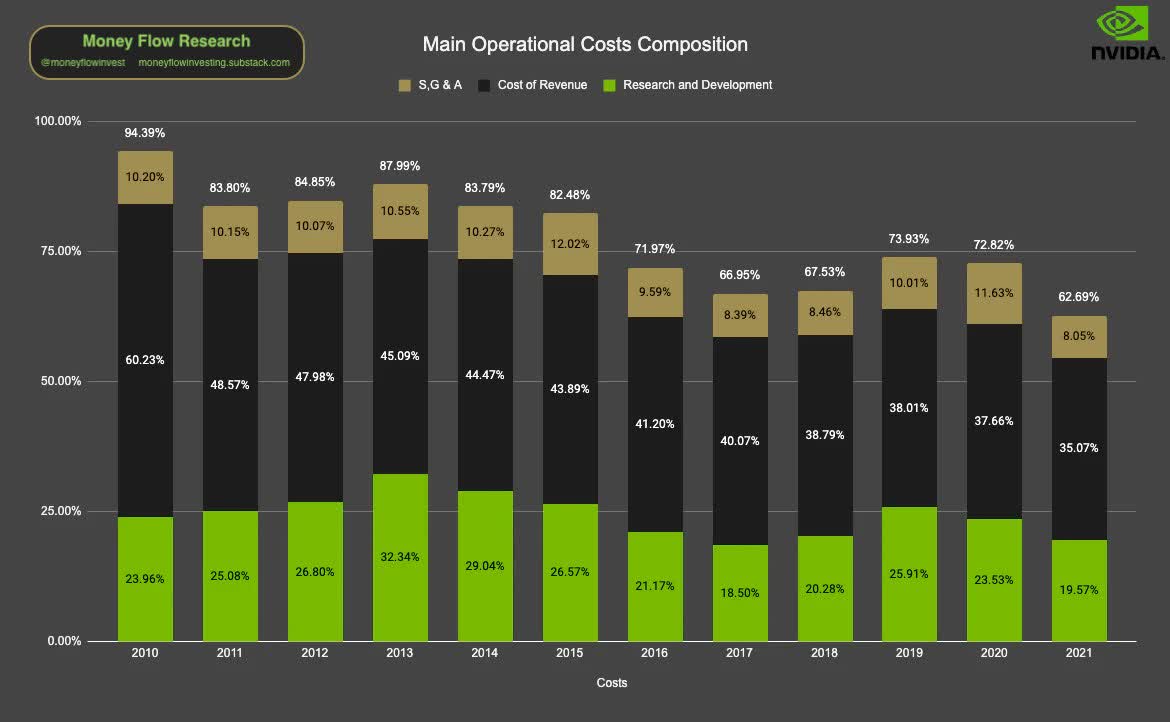
Steady Progress Toward the Proliferation of Nvidia AI
Within the data center segment, hyperscalers (think cloud companies like AWS) and vertical enterprises continue to purchase Nvidia’s products like hotcakes. For instance, Meta (META) announced in early 2022 that it is building out “the world’s fastest AI supercomputer” with sixteen thousand A100 Tensor Core GPUs later this year. Similarly, Tesla (TSLA) unveiled in 2021 that it was using nearly six thousand A100s to train deep neural networks for its autopilot system and self-driving capabilities. Additionally, all major cloud providers offer A100 Nvidia GPU-accelerated instances. The success with its hyperscaler partners is impressive, considering many of them design their own proprietary data center chips.
Nvidia AI Data Center Progress (Nvidia Investor Day 2022 Presentation)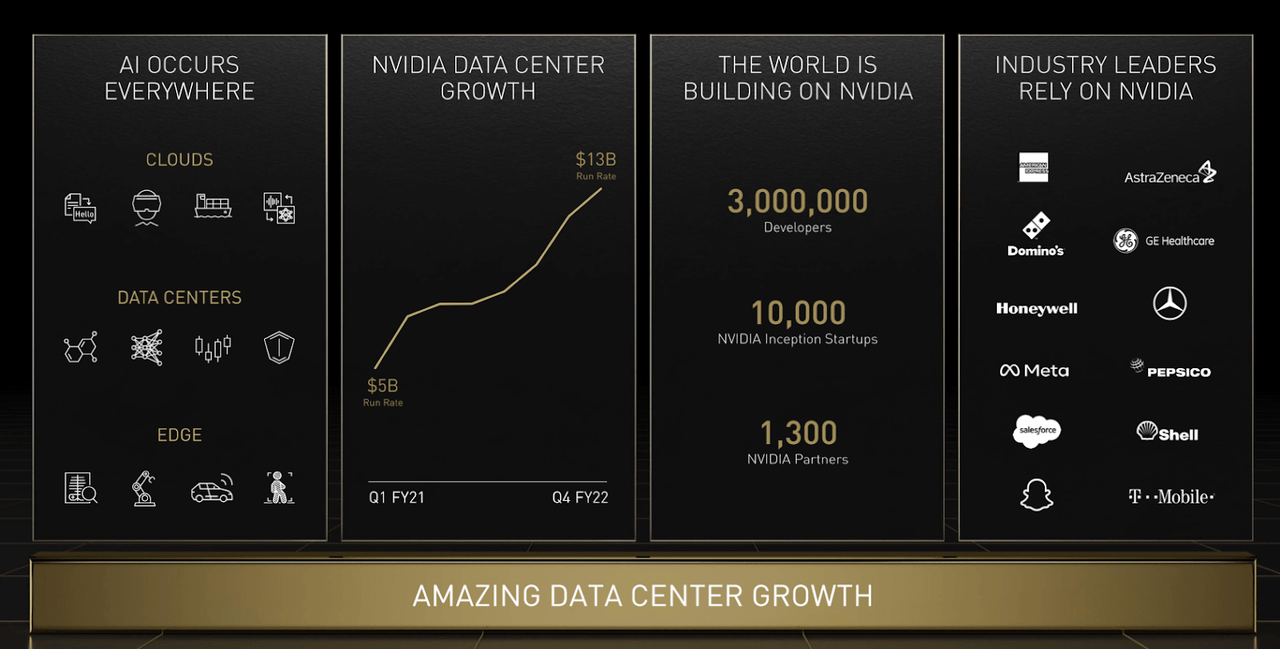
A considerable tailwind for the fast adoption of Nvidia AI is the rapidly increasing complexity of training and inference workloads. Major revolutionary breakthroughs within the past three years have raised the bar for computational demands. These discoveries include natural language processing and Deep Learning Recommender System (DLRM). Underpinning both of these models is the concept of a transformer. Transformers enable neural networks to learn contextually without requiring an extensive human-labeled data set, which is highly costly and time-consuming to procure. According to the company, these two areas are driving enormous investments in cloud service providers to train these sophisticated models without sacrificing speed. Furthermore, the firm announced the turbocharged H100 data center GPU at the 2022 GTC. Designed with its next-gen Hopper architecture, the H100 was architected with an advanced transformer engine to support these cutting-edge models.
One of management’s big audacious goals is to democratize AI by making it more accessible to all businesses regardless of their technical core competencies. In this envisioned future, corporations of varying sizes will purchase licenses for AI capabilities from Nvidia, similar to how companies today buy mission-critical subscriptions to support business operations from firms such as Salesforce (CRM), Microsoft (MSFT), or Adobe (ADBE). To accomplish this vision and capture the estimated $300 billion market for AI Enterprise and Omniverse Enterprise software, the CEO, Jensen Huang believes Nvidia must bundle up the software and hardware components into a complete, ready-to-use package for its customers. This bundling is necessary because many enterprises do not have the technical ability or resources to build proprietary AI solutions. Additionally, developing a homegrown system would require an enormous effort to stitch together the complex algorithms, system software, networking, and storage components. With the launch of its new data center AI Enterprise software services, the company is one step closer to making this a reality. For instance, its newly minted Base Command and Fleet Command IT solutions orchestrate the development and deployment of AI software at the data center and the edge at scale. These services will work on top of VMWare vSphere, the de-facto data center platform. The business is addressing a critical IT infrastructure gap that will ease technical burdens and lower AI adoption barriers.
Nvidia Enterprise Computing Market Opportunity (Nvidia Investor Day 2022 Presentation)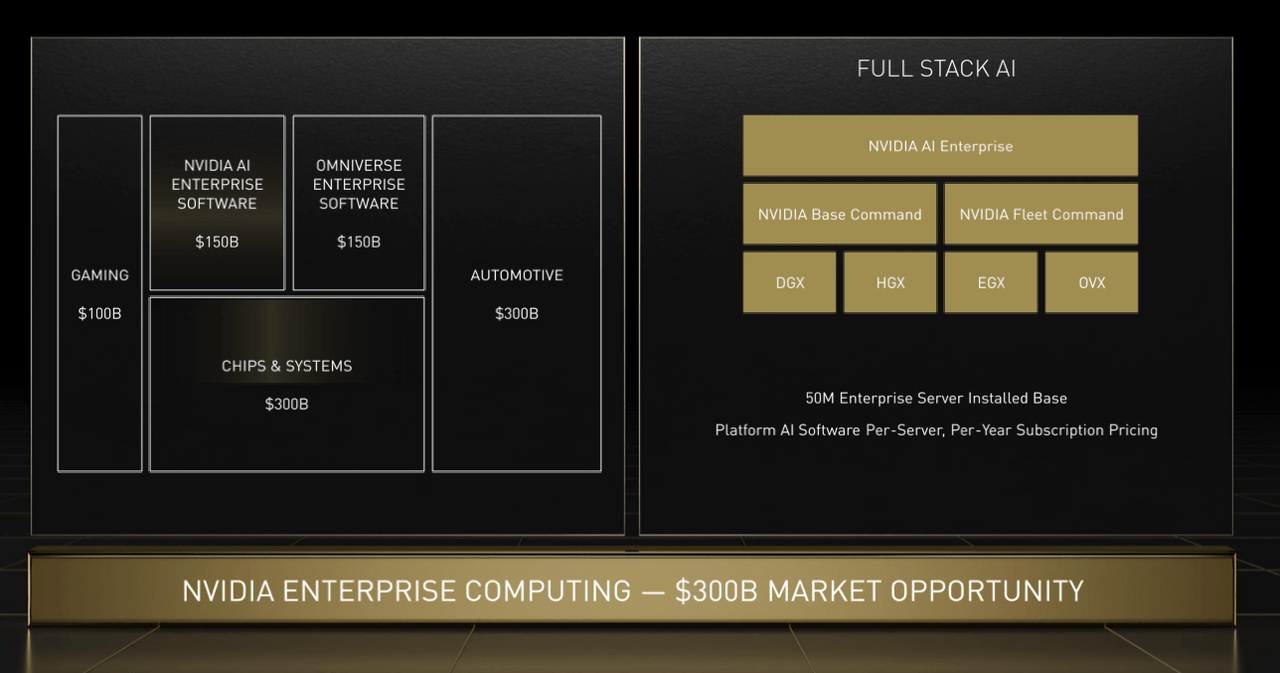
The Professional Visualization and Auto segments are still subscale and represent only ~10% of sales. I believe these business units have tremendous growth ahead of them. Management is pouring lots of capital into both segments with its Omniverse Enterprise AI and DRIVE Hyperion platforms.
On the Professional Visualization end, Nvidia is starting to ramp up its Omniverse enterprise software, which has serious potential to generate enormous incremental high-margin SaaS revenues. These days, investors are understandably skeptical of the Metaverse hype. META, for example, is hinging much of its future success on producing the metaverse. It is allocating significant resources toward that end. In 2022, investors are not inclined to pay for this upside (and potentially assign a negative valuation to the venture) considering a mere ~9x EV-to-EBIT for the entire business despite a high-quality core operating business gushing free cash flow.
Nvidia has a vastly different strategic position toward virtual or augmented worlds that is quickly gaining commercial traction. Management is focused on two primary opportunities in this space. The first is Omniverse for Designers, which enables creators worldwide to collaborate within 3D virtual spaces to design and build products. The second is digital twins for companies to unlock operational efficiencies and maximize productivity for client-facing and production-related processes. For example, Amazon (AMZN) uses digital twins to optimize digital warehouse design and flow and train intelligent robots. Kroger (KR) is utilizing it to maximize store efficiency by creating digital twins of its supermarkets to simulate and iterate over various floor plan layouts before it allocates resources to make modifications across its physical locations. According to Nvidia’s VP of Omniverse, BMW is saving up to 30% on their costs with the use of a factory digital twin. In any case, Nvidia is selling licenses at $9k per year for a workgroup of 2 Creators, 10 Reviewers, and 4 Omniverse Nucleus (the collaboration engine which manages asset interchange and version control) subscriptions. Management believes that this new business will spur a virtuous cycle. The idea is that license purchases will lead to more hardware sales. In turn, the increased hardware sales will boost production capacity and influence customers to purchase even more licenses. Nvidia already sees early success. For example, after announcing the product in Q2 2021, Nvidia has already signed up 10% of the world’s top 100 companies with ~200k software downloads and nearly 300 companies evaluating.
In the auto market, the company has cultivated an $11 billion pipeline and counting through 2027. Nvidia has partnerships with a handful of marquee names such as Mercedes (OTCPK:DMLRY), Jaguar/Land Rover (TTM), Volvo (OTCPK:VLVLY), Polestar, Amazon’s ZOOX, DiDi, Polestar, BYD (OTCPK:BYDDY), NIO, and more. Three of these deals have recurring revenue characteristics in which the company splits the fees from over-the-air updates to the vehicles. This revenue stream will start flowing through in 2024 and 2025 for Mercedes and Jaguar/Land Rover, respectively.
Nvidia Automotive Design Pipeline (Nvidia Q1 2022 Investor Presentation)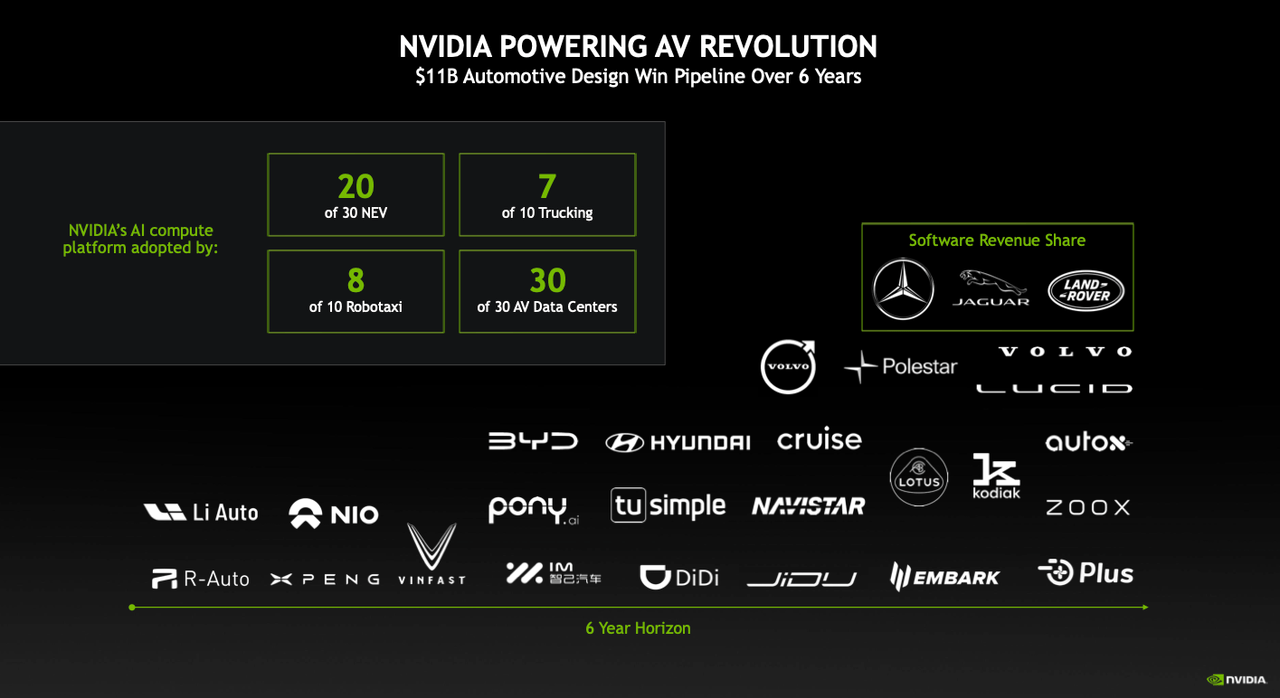
Risks
Fast Pace of Technological Innovation Weakens Competitive Position
The GPU is not the only show in town. There are other types of accelerators such as CPUs, ASICs, TPUs, and FPGAs. Money is pouring into the sector with the rapid rise and proliferation of machine learning applications. This investment has caused an explosion of new and exciting silicon chips. Traditional semiconductor businesses like Intel, AMD, and Xilinx invest heavily in developing AI processors. The major cloud companies vertically integrate backward and produce specialized silicon, such as Google with the TPU and Alibaba with the Yitian 710. Cloud businesses have a compelling incentive to build proprietary infrastructure to reduce costs at scale and forge their competitive advantages around computing power.
Commoditization Risk
Any undifferentiated product is at risk of turning into a commodity. Technology is specifically vulnerable to the commoditization process since innovation moves quickly. Once a company invents a cutting-edge product that gives it an edge in the market, history tells us that the natural progression is for competitors to attempt to clone and catch up. For instance, in the late 1990s, IBM figured out a method to use copper wiring in integrated circuits. IBM spent plenty of money and undertook years of research to accomplish this. Unfortunately for IBM, competitors copied it just two years later after its supplier partnered with them.
Additionally, the technological leader must allocate a significant amount of its capital toward R&D expenses to innovate. The business that copies can do so through less expensive means such as poaching employees from the firm, working with suppliers, or reverse-engineering to replicate an existing product. Nvidia may experience a similar dynamic. The competitive landscape is fierce as substantial capital is flowing into semiconductor companies. According to PitchBook, venture capital firms have invested over $11 billion into the United States silicon chip startups since 2012. The race to develop the best chips in the world constantly keeps Nvidia on its toes. Rapid industry innovation increases the chance that peers create similar products and services that would preclude Nvidia from demanding a hefty premium in an increasingly fragmented environment.
The Valuation of a Generational Compounder
In my view, the company has years of 25%+ compounded growth ahead of it. It is challenging for businesses to maintain such as growth rate after enjoying a 28% seven-year CAGR. Nvidia is no ordinary business. There are three main drivers for this optimistic outlook.
- Its economic moat and competitive lead are growing noticeably wider. For instance, starting in 2012, Nvidia’s management has increased the Owner’s Earnings ROTC from a base of mid-teens ROTC to the low 30s. Management’s continued execution of constructing a sustainable competitive advantage will enable it to maintain or increase its market share and ROTC.
- Between Enterprise AI, Omniverse, GeForce NOW, and other forthcoming software services, high-margin recurring revenue will become a sizable portion of its total sales over the next 5-10 years. For enterprise software, the adoption rate will pick up momentum as companies realize the significant cost savings they can unlock through virtual simulation and leveraging AI. For GeForce NOW, gamers are drawn toward a low-monthly payment model to access the latest and greatest GeForce GPUs.
-
All four of its markets have expanding TAMs. Management believes this number amounts to $1 trillion. The true number is hard to quantify since Nvidia is entering into newly formed markets that it has virtually paved for itself.
Owners Earnings = Normalized Operating Cash Flow – Maintenance Capital Expenditures + Income Tax
Bonus Reason: This thing is founder-led. Jensen Huang is an exceedingly skilled CEO on a mission to see this evolve into one of the largest companies in the world. This rare combination of passion and talent is an intangible asset not captured on the balance sheet. He also has plenty of skin in the game.
Nvidia Insider Ownership (Nvidia 2022 Proxy)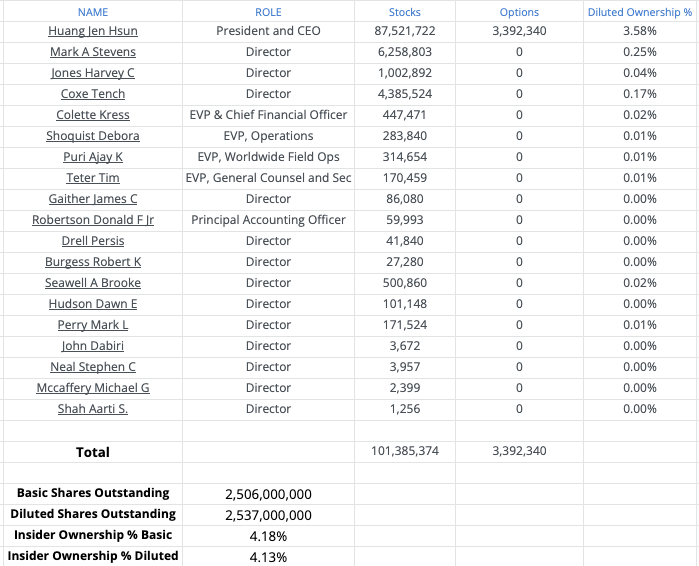
Nvidia Compensation Components of Pay (Nvidia 2022 Proxy)
The management is aligned with its shareholders with its incentive structure. I would have also included ROIC or ROE, but the combination of revenue growth, adjusted operating income growth, and TSR (total shareholder return) will suffice. I don’t love that the company excludes share-based compensation from the adjusted operating income metric. However, I will cut the board of directors a little slack since this unfortunate practice has become an industry-wide standard and the management team has produced stellar results with this criteria over the past decade.
NVDA Valuation Summary (Author)
While I typically do not forecast 20%+ growth over multiple years for businesses, Nvidia is the exception. Ultimately, my high conviction bet is that there is a long runway ahead. Without this confidence, the stock looks optically overvalued at a 1.63% owner’s earnings yield and a ~41x NOPAT. In return for paying a premium, you are purchasing a well-managed business whose free cash flow will compound rapidly.
Conclusion
Nvidia is building an entire Apple-like ecosystem from the lower-level hardware all the way up the stack to AI business application-level software. Customers are partnering with Nvidia to simulate digital versions of physical objects in order to cut costs and streamline operations. As more firms realize the benefits of harnessing the power of AI, thousands of more businesses will have no choice but to purchase AI Enterprise licenses in order to keep up. In my opinion, Nvidia is one of the most compelling business growth stories over the next decade.


Be the first to comment